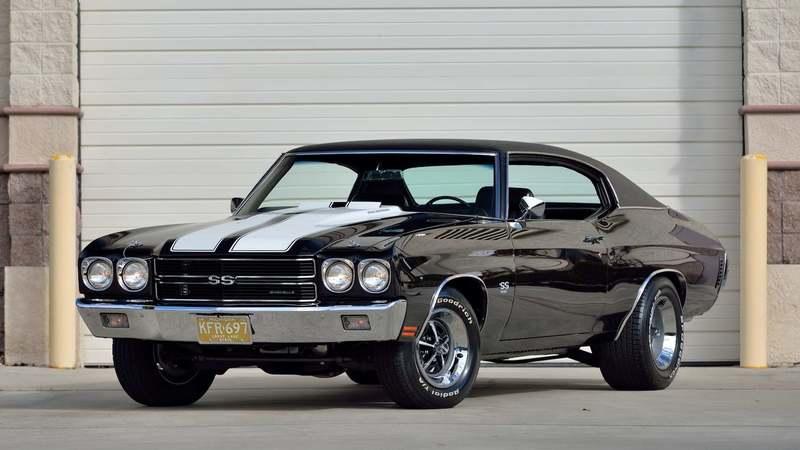
Classic muscle cars used to be a popular choice for those who wanted speed but had limited funds. Luckily, today's convertible muscle cars offer all of the fun of the classic models. Here are four of the most iconic convertible muscle cars to buy. Continue reading for more details. We'll take a look at the Chevrolet Camaro (the Pontiac Firebird), the Dodge Challenger, the Plymouth Superbird, and the Pontiac Firebird.
Chevrolet Camaro
1968 Chevrolet Camaro - A classic muscle car. The convertible's engine is not a V8 like its predecessors. The Camaro's turbo-4 produces 275 horsepower, and 295 lb-ft torque. The turbo-four will take you from zero to sixty in 5.5 seconds. It does not produce the characteristic exhaust note that a true V8 engine produces. While the Camaro might not sound like a V8, the Turbo 4 still has attitude. The real fun lies behind the wheel, even though the car boasts advanced safety features.
The interior is sparse, but it's pleasant enough. The cupholders are a decent size, and the back seat is removable and can be used as extra storage space. The luxurious trim has hard plastics, and offers quiet, comfortable riding. The climate control unit is located near the shift lever. This makes it easy for you to adjust the temperature and the air conditioner. Despite these imperfections, the Chevy Camaro's interior makes it a pleasant place to spend a day with the family.

Dodge Challenger
The Dodge Challenger is a two door coupe imported from Mitsubishi. It came in two sizes: a 1.6-liter I-4 and a 2.6-2, 105-horsepower 4-cylinder. In 1981, the Challenger was redesigned and survived until 1984 when it was replaced with K-platform compacts by Chrysler Corporation and an import from Mitsubishi. However, the Challenger's enduring popularity helped make the convertible model a classic.
Before the Challenger was officially introduced in 2008, the company had already planned to offer it as a convertible. The convertible Challenger was actually seen being taken to a scrapyard as a prototype. It is now in its thirteenth year of production. Although its popularity has waned, the Challenger is still a desirable muscle car, and aftermarket modifications are common. Here are some of the features that make Challenger convertibles a popular choice for muscle car enthusiasts.
Pontiac Firebird
The Pontiac Firebird, a muscle car convertible that was introduced in 1967, was the classic Pontiac Firebird. It was a two-door coupe with an F-body engine that produced 165 horsepower. It was also equipped with optional Tri-Power motor. GM considered the Firebird a risky purchase at first. They weren't sure if it would be a good seller. The basic principles of a regular car were used to create something entirely new.
A completely new look was applied to the 1968 model. It was equipped with wraparound side marker lights, a new front fascia, and a Pontiac Arrowhead logo. The instrument panel and steering wheel were replaced. The Firebird became more functional thanks to this upgrade. Despite its new design, it retained the Firebird's performance-driven heritage. It retains the unique Pontiac style it was originally designed for.

Plymouth Superbird
The Plymouth Superbird muscle car is a classic American muscle car. It was designed by Chrysler engineers to comply with NASCAR homologation requirements. The car's revolutionary wedge-like nose design and two-foot tall rear spoiler allowed it to reach speeds previously unimaginable. Superbird was a big hit on the track as well as the streets. The company produced approximately 2,000 Superbirds in 1970.
The Superbird featured three engine options: the 440 Super Commando, the 426 Hemi V8 and the 440 Super Commando six-barrel. The 440 Super Commando Six-Barrel produced 390 horsepower, and was equipped with three two-barrel carburators. Also available was the 380 hp 440 engine (240 kW), and a 375hp 280 kW engine.
FAQ
Is it possible to work as an automotive mechanic?
It can be done. Many garages post their vacancies online. Many people apply simply because they think it might make them feel good. If you want to get your foot in the door, you should try applying for a few places and see if they accept student applications. If you don't know anyone working in the industry, ask your friends and relatives. They might be willing to recommend someone.
How do I fix my vehicle as a hobby?
It's a great hobby to take on if you are passionate about cars. You can repair them, buy their parts, sell them, or just have fun with them. It's a fun hobby that you can do if it interests you.
But it is not easy to turn this into your full-time occupation. It takes a lot of dedication and hard work. It requires a lot investment.
You may not be able to have an emotional connection with cars unless there is a valid reason.
What is the length of an apprenticeship as an automotive mechanic?
It takes approximately three years to complete an automotive mechanic apprenticeship. This includes two years at school and two years working as an apprentice. The first year teaches you all aspects, from theory to practical skills and safety procedures. You will also learn to use tools efficiently and safely during this period. After the completion of the first year, you will spend another year on the job training. Here you'll gain valuable experience in different trades. These years will offer you the opportunity to attend formal classes.
The last year of your program will be spent earning qualifications and becoming certified. These include NVQs (National Vocational Qualifications), which are awarded after passing exams covering specific topics within the industry. The HNCs (Higher National Certificates), on the other hand, cover general subjects like customer service and management. City & Guilds certificates can be obtained for individuals who want to learn certain trades.
How can I prepare myself for a mechanic apprenticeship
It is important that you understand the ramifications of your actions. It is important to know the basics of how cars work. This will allow you to be prepared for your first day at work.
You should also know how to fix common problems such as tires or broken lights.
This should help you learn how to diagnose issues and repair them yourself.
You'll also need to know how different parts fit together to put them back together again.
And finally, you must know how to use tools safely and efficiently.
These are all things that will make you a competent mechanic.
Is it difficult to become a mechanic apprentice
It's not easy, but you learn fast, and there are many opportunities for advancement.
You will need to be patient and persevering. Also, you must know how to fix trucks, cars, and motorcycles.
Customers and family members will put pressure on your shoulders to help you succeed. However, you shouldn't be forced to make difficult decisions.
If you enjoy fixing cars, it could be a great career choice. It's a job where you can earn a decent salary and build up your business.
However, you might prefer to go down another route. You might consider becoming a technician in this instance.
This is where you use your technical skills to support other workers. Technical support could include helping technicians to troubleshoot issues or teaching them new techniques.
You can also become a service advisor. This is where you can offer advice and assistance to customers who bring their vehicles to a garage.
Your decision will be based on what your priorities are. There are plenty of options available, and you can choose which suits you best.
Statistics
- There were 749,900 jobs available for automotive service technicians and mechanics in 2016, which is expected to grow by six percent through 2026. (jobhero.com)
- Apprentice mechanics earn significantly less hourly than mechanics who have completed training, with a median wage of approximately $14.50 an hour, according to PayScale. (jobhero.com)
- 52% of Mechanics in the United States think their salaries are enough for the cost of living in their area. (indeed.com)
External Links
How To
How to Become an Auto Technician
An automotive technician provides repair services and maintenance to vehicles. He/she works at car dealerships, auto shops, garages, service centers, etc. He/she assists customers in fixing their cars, trucks or motorcycles. An automotive technician must be capable of diagnosing problems and making repairs safely, accurately and efficiently.
A person who wants to work as an automotive technician should first obtain an associate degree from a vocational school. After completing this program, he/she will need to pass the National Institute for Automotive Service Excellence's (ASE) certification exam. ASE stands to American Society of Mechanical Engineers. The ASE certification test consists of two sections. The first section tests your mechanical skills, while the second tests your practical knowledge. You will need to attend an authorized testing site in order to pass the test. These locations are available online or through your local automotive dealer.
After passing the exam, a candidate must take a state exam before being licensed as an automobile technician. This process can vary depending on where the applicant lives. Some states require that candidates attend training courses, while others permit them to learn independently. Some states issue licenses to technicians as soon as they get their license. Others wait until they have worked at least six months as an automotive technician.
Apply to your local dealership to become an automotive technician. Most new employees work as apprentices after they have been hired. Apprenticeship programs last about three years. This is when a student can learn how to do basic repairs such as changing oil, adjusting brakes and replacing tires. Advanced repairs can be done by some students, including replacing shocks, installing air filters and repairing engines. Many schools offer classes during normal business hours. Some schools also offer evening classes when needed.
Once a student finishes his/her apprenticeship, it is possible to become a Journeyman. Journeymen usually spend four to five year learning how to install major systems like transmissions, differentials steering gear, suspensions, drive shafts, and steering gear. They are also taught how to troubleshoot electrical components and remanufacture engines. Because they have a good understanding of the job and what customers expect, many employers prefer to hire journeymen.
After passing the exams, candidates may be eligible to open their own shop if they pass all requirements. According to the Bureau of Labor Statistics in 2010, nearly 1.7 Million automotive mechanic jobs were available. This figure is expected to rise 18 percent between 2009-2020. Candidates who decide to open their own business should be prepared to invest thousands in equipment and supplies.
The salary of an automotive technician will depend on many factors including where you live, your education level, experience and the type of employer. A jobless person can expect to make $20,000 per year. Someone who has only a highschool diploma could earn around 21,000 dollars per year. An associate's degree earns approximately $24,000 annually. Technicians with a bachelor's degree earn about $27,000 per annum. The average annual salary for those with master's degrees was $32,000. Salaries are increasing so that a professional earning less than $30,000 could expect to make $40,000 in a few years.